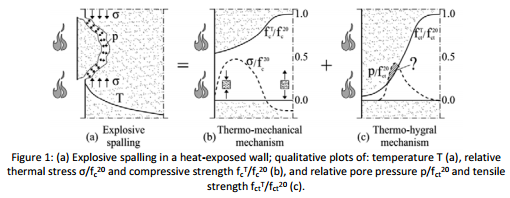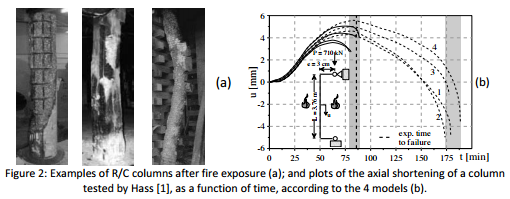Reinforced Concrete in Fire: from Materials Behaviour to Spalling Sensitivity and Structural Modeling
The increasing use of High-Performance Concrete (HPC) in many structures exposed to extreme environmental conditions (tunnels, containment shells,...) bring in new problems, which go beyond the excellent knowledge we have on Normal-Strength Concrete (NSC).
Tratto da: PhD Students ACI Awards
Innovation in Concrete Structures and Cementitious Materials
Vincitore Premio Federbeton 2016
ABSTRACT
The increasing use of High-Performance Concrete (HPC) in many structures exposed to extreme environmental conditions (tunnels, containment shells,...) bring in new problems, which go beyond the excellent knowledge we have on Normal-Strength Concrete (NSC). In the specific case of high temperature, at least two topics need to be further investigated and are considered in this project: (a) numerical modelling of R/C structures, and (b) concrete spalling (namely, the explosive expulsion of concrete pieces due to thermal stresses and vapour pressure in the pores, see Figs.1 and 2a).


The second topic mainly concerns HPC. Its low porosity, in fact, is a pro in ordinary conditions (being the durability improved), but brings in higher pore pressures because water vaporization and vapour release occur in a low-permeability continuum. Since spalling phenomenon is strictly related to water vaporization and moisture transport, heat-exposed R/C structures bring in a hygro-thermo-mechanical problem, whose solution, however, is no easy matter and often goes beyond the objectives of structural engineering. So, a two-step approach is herein proposed: firstly, investigation on R/C structural response at high temperature (neglecting spalling), and secondly, experimentation on concrete spalling sensitivity.
As for structural numerical modelling, concrete behaviour at high temperature has to be properly trated, taking into account both mechanical and geometrical nonlinearities (the former induced by irreversible temperature-related strains – i.e. thermal transient strain –, and the latter by the dramatic stiffness decrease). Within this context, a critical study on four concrete constitutive models available in the literature was performed (Anderberg and Thelandersson [1], Model 1; Khoury and Terro [2], Model 2; Schneider et al. [3], Model 3; and EC2 [4], Model 4), to check their efficacy and to understand the role of the main parameters involved. To this end, a Beam FiniteElement
Code was developed by using FORTRAN solver, and 55 R/C columns tested at the University of Braunschweig [5] and of Ghent [6] were modelled numerically.
As an example, the results of a heat-exposed pinned-pinned column, subjected to an eccentric load are presented in terms of vertical shortening in Fig.2b. Numerical analyses were performed considering or neglecting second-order effects (continuous/
dashed lines). The two grey areas indicate the two ranges of time to failure bounded by the 4 constitutive models. Only introducing second-order effects (with a sizable 4623 reduction of the fire resistance), the experimental time to failure is comprised in such range. The numerical analysis applied to 55 real-scale tests on R/C columns proved that Models 1 and 2 give values of time to failure 17% lower (on average) than the experimental tests, while Models 3 and 4 give values 9 and 4% lower, respectively.
The satisfactory agreement between the numerical and experimental results allows to conclude that taking into account thermal transient strains and secondorder effects is necessary to capture the actual behaviour of R/C members in fire.
As for spalling, in spite of the many studies performed in the last twenty years, to what extent pore pressure affects concrete tensile behaviour and what is the role of concrete mix design are still open issues. To give an answer, an innovative technique
has been developed (Figs.3a,b) and an experimental investigation has been carried out on 3 concrete classes (fc = 40, 60 and 90 MPa), with 3 aggregate types (silicocalcareous, calcareous and basalt), with/without polypropylene (pp) fibres. Concrete cubes (L = 10 cm) were heated on two opposite sides, while sealed and thermally insulated on the others (Figs.3a,b). Pressure and temperature were monitored in the centroid; when the maximum pore pressure was reached, a splitting test was performed, inducing the fracture in the symmetry plane of the specimen (Fig.3b [7]).
Pore pressure-vs-tensile strength plots were interpolated by means of linearregression curves, whose slope k stands for the indirect tensile-strength loss-rate due to pore pressure. As shown in Fig.3c, both the maximum pore pressure pmax and the
strength-loss rate k are a function of concrete mix design: increasing the compactness

(and decreasing the porosity), higher pore pressures and lower values of k were obtained (Fig.3c).
To take into account these opposite trends, a spalling index risk was defined, Sp = pmax/fctT.k = ΔfctT /fct T . The experimental results prove that the spalling risk decreases if the amount of monofilament pp fibres is increased (while fibrillated pp fibres seem to bring in no sizable advantages) and if basalt aggregate is preferred to calcareous or mixed aggregate. The findings of this study give fresh – and largely new – information useful to understand spalling phenomena, with the aim of giving cement producers and R/C designers indications on how to improve the performance of R/C structures in fire.
